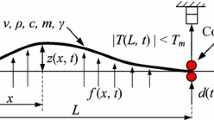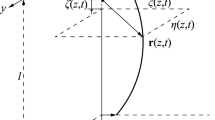Abstract
The axially translating string has received wide attention due to its adverse effect of transverse vibration on security and stability in engineering. Most of the current literature focuses on classical boundary cases (e.g., fixed boundary, free boundary), while non-classical boundaries, such as damped boundary, spring-damped boundary, and mass-spring-damped boundary, are more relevant because they are in line with engineering practice. Boundary damping has a significant effect on system vibration, and the damping-damping boundary has rarely been studied. Thus, this paper is dedicated to the modeling, calculation and vibration passive control of a translating string with damping at both ends. First, the equations of motion and boundary conditions are deduced according to extended Hamilton’s principle, with the boundary damping forces as the controlling forces. Second, the analytical solutions of vibration response and system energy expressions are derived using the reflected traveling wave superposition method (RTWSM). Next, to stabilize the system under the boundary damping forces, the boundary damping ranges that satisfy the exponential decay of the system energy are obtained. To further solve for optimal damping in the above ranges, RTWSM model and the boundary energy reflection are employed. Finally, the vibration responses of translating strings with different boundary damping values are simulated. The result shows that boundary damping in feasible intervals facilitates vibration attenuation effectively.









Similar content being viewed by others
References
Pham, P.T., Hong, K.S.: Dynamic models of axially moving systems: a review. Nonlinear Dyn. 100(1), 315–349 (2020)
Hong, K.S., Chen, L.Q., Pham, P.T., Yang, X.D.: Control of Axially Moving Systems. Springer, Singapore (2022)
Marynowski, K., Kapitaniak, T.: Dynamics of axially moving continua. Int. J. Mech. Sci. 81, 26–41 (2014)
Zhang, N.H., Wang, J.J., Cheng, C.J.: Complex-mode Galerkin approach in transverse vibration of an axially accelerating viscoelastic string. Appl. Math. Mech.-Engl. Ed. 28(1), 1–9 (2007)
Chen, L.Q., Zhao, W., Ding, H.: On Galerkin discretization of axially moving nonlinear strings. Acta Mech. Solida Sin. 22(4), 369–376 (2009)
Asnafi, A.: Melnikov-based criterion to obtain the critical velocity in axially moving viscoelastic strings under a set of non-Gaussian parametric bounded noise. Acta Mech. 232(9), 3495–3508 (2021)
van Horssen, W.T., Ponomareva, S.V.: On the construction of the solution of an equation describing an axially moving string. J. Sound Vib. 287(1–2), 359–366 (2005)
Ghayesh, M.H., Moradian, N.: Nonlinear dynamic response of axially moving, stretched viscoelastic strings. Arch. Appl. Mech. 81(6), 781–799 (2011)
Yang, X.D., Wu, H., Qian, Y.J., Zhang, W., Lim, C.W.: Nonlinear vibration analysis of axially moving strings based on gyroscopic modes decoupling. J. Sound Vib. 393, 308–320 (2017)
Gaiko, N.V., van Horssen, W.T.: On the transverse, low frequency vibrations of a traveling string with boundary damping. J. Vib. Acoust.-Trans. ASME. 137(4), 041004 (2015)
Gaiko, N.V., van Horssen, W.T.: Resonances and vibrations in an elevator cable system due to boundary sway. J. Sound Vib. 424, 272–292 (2018)
Chen, E.W., Ferguson, N.S.: Analysis of energy dissipation in an elastic moving string with a viscous damper at one end. J. Sound Vib. 333(9), 2556–2570 (2014)
Chen, E.W., Li, M.B., Ferguson, N., Lu, Y.M.: An adaptive higher order finite element model and modal energy for the vibration of a traveling string. J. Vib. Control. 25(5), 996–1007 (2019)
Chen, E.W., Zhang, K., Ferguson, N.S., Wang, J., Lu, Y.M.: On the reflected wave superposition method for a travelling string with mixed boundary supports. J. Sound Vib. 440, 129–146 (2019)
Chen, E.W., Luo, Q., Ferguson, N.S., Lu, Y.M.: A reflected wave superposition method for vibration and energy of a travelling string. J. Sound Vib. 400, 40–57 (2017)
Ulsoy, A.G.: Vibration control in rotating or translating elastic systems. J. Dyn. Syst. Meas. Control-Trans. ASME. 106(1), 6–14 (1984)
Fung, R.F., Liao, C.C.: Application of variable structure control in the nonlinear string system. Int. J. Mech. Sci. 37(9), 985–993 (1995)
Wang, L., Chen, H.H., He, X.D.: Active H∞ control of the vibration of an axially moving cantilever beam by magnetic force. Mech. Syst. Sig. Process. 25(8), 2863–2878 (2011)
Hong, K.S., Pham, P.T.: Control of axially moving systems: a review. Int. J. Control Autom. Syst. 17(12), 2983–3008 (2019)
He, W., Qin, H., Liu, J.K.: Modelling and vibration control for a flexible string system in three-dimensional space. IET Contr. Theory Appl. 9(16), 2387–2394 (2015)
Yang, B.: Noncolocated control of a damped stringusing time delay. J. Dyn. Syst. Meas. Control-Trans. ASME. 114(4), 736–740 (1992)
Nguyen, Q.C., Hong, K.S.: Asymptotic stabilization of a nonlinear axially moving string by adaptive boundary control. J. Sound Vib. 329(22), 4588–4603 (2010)
Cheng, Y., Wu, Y.H., Guo, B.Z.: Absolute boundary stabilization for an axially moving Kirchhoff beam. Automatica 129, 109667 (2021)
Fung, R.F., Wu, J.W., Lu, P.Y.: Adaptive boundary control of an axially moving string system. J. Vib. Acoust.-Trans. ASME. 124(3), 435–440 (2002)
Lee, S.Y., Mote, C.D.: Vibration control of an axially moving string by boundary control. J. Dyn. Syst. Meas. Control-Trans. ASME. 118(1), 66–74 (1996)
Foda, M.A.: Vibration control and suppression of an axially moving string. J. Vib. Control. 18(1), 58–75 (2012)
Moslemi, A., Khadem, S.E., Khazaee, M., Davarpanah, A.: Nonlinear vibration and dynamic stability analysis of an axially moving beam with a nonlinear energy sink. Nonlinear Dyn. 104(3), 1955–1972 (2021)
Hao, M.Y., Ding, H., Mao, X.Y., Chen, L.Q.: Stability and nonlinear response analysis of parametric vibration for elastically constrained pipes conveying pulsating fluid. Acta Mech. Solida Sin. (2022). https://doi.org/10.1007/s10338-022-00370-z
Chen, E.W., Yuan, J.F., Ferguson, N.S., Zhang, K., Zhu, W.D., Lu, Y.M., Wei, H.Z.: A wave solution for energy dissipation and exchange at nonclassical boundaries of a traveling string. Mech. Syst. Sig. Process. 150, 107272 (2021)
Kim, C.W., Hong, K.S., Park, H.: Boundary control of an axially moving string: actuator dynamics included. J. Mech. Sci. Technol. 19(1), 40–50 (2005)
Lee, S.Y., Mote, C.D.: A Generalized treatment of the energetics of translating continua, part I: Strings and second order tensioned pipes. J. Sound Vib. 204(5), 717–734 (1997)
McIver, D.B.: Hamilton’s principle for systems of changing mass. J. Eng. Math. 7(3), 249–261 (1973)
Kreyszig, E., Kreyszig, H., Norminton, E.J.: Advanced Engineering Mathematics. Wiley, New York (2011)
Gaiko, N.V., van Horssen, W.T.: On wave reflections and energetics for a semi-infinite traveling string with a nonclassical boundary support. J. Sound Vib. 370, 336–350 (2016)
Acknowledgements
This work was supported by the Natural Science Foundation of Anhui Province [Grant Number 2208085ME130] and the National Natural Science Foundation of China [Grant Numbers 51675150, 51305115]. On behalf of all authors, the corresponding author states that there is no conflict of interest.
Author information
Authors and Affiliations
Corresponding author
Ethics declarations
Conflict of interest
The authors declare that they have no known competing financial interests or personal relationships that could have appeared to influence the work reported in this paper.
Additional information
Publisher's Note
Springer Nature remains neutral with regard to jurisdictional claims in published maps and institutional affiliations.
Appendix A. The derivation of governing equation and boundary condition.
Appendix A. The derivation of governing equation and boundary condition.
In order to simplify the derivation, the notation La shown in Eq. (A.1):
Then, according to Eqs. (2) and (3), the following equation is obtained:
We integrate it by parts, the Eq. (A.2) can be written in the following form:
Because the variations at T1 and T2 are zero, i.e., δU(X,T1) = δU(X,T2) = 0, the last term in Eq. (A.3) vanishes. Then, we substitute Eqs. (4), (5) and (A.3) into Eq. (1),
Thus, the governing equation and boundary conditions at X = 0 and X = L are obtained as follows:
Rights and permissions
Springer Nature or its licensor (e.g. a society or other partner) holds exclusive rights to this article under a publishing agreement with the author(s) or other rightsholder(s); author self-archiving of the accepted manuscript version of this article is solely governed by the terms of such publishing agreement and applicable law.
About this article
Cite this article
Wu, Y., Chen, E., Dong, G. et al. On vibration and passive control of axially translating string with damping at both ends using reflected traveling wave superposition method. Acta Mech 234, 4917–4937 (2023). https://doi.org/10.1007/s00707-023-03635-x
Received:
Revised:
Accepted:
Published:
Issue Date:
DOI: https://doi.org/10.1007/s00707-023-03635-x




